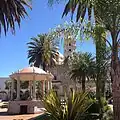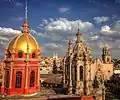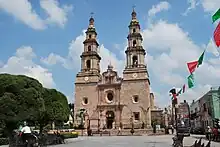Los Altos de Jalisco
Los Altos de Jalisco, or the Jaliscan Highlands, is a geographic and cultural region in the eastern part of the Mexican state of Jalisco, famed as a bastion of Mexican culture, cradling traditions from Tequila production to Charrería equestrianism. Los Altos are part of the greater Bajío (The Lowlands) region of Mexico.
Los Altos de Jalisco
Jaliscan Highlands | |
|---|---|
Region of Mexico | |
.jpg.webp) .jpg.webp) .JPG.webp)   | |
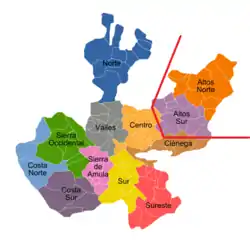 | |
| Coordinates: 21.17°N 104.41°W | |
| Municipalities | 21 |
| State | |
| Population (2010) | |
| • Total | 925,648 |
| Demonym(s) | Alteño(a) Spanish for Highlander |
Los Altos is primarily a rural or semi-rural region, known for its towns of historic Mexican colonial architecture, deep Catholic conservatism[1][2] and numerous Mexican traditions such as equestrianism, mariachi music, tequila production, and traditional Mexican dances and festivals. A significant portion of the population consists of Mexicans of European descent, primarily from the criollos of Castillian, Extremaduran, Galician, Basque, and Andalusian origin, but also from early Portuguese settlers and later immigrants from other parts of Europe.[3][4][5][6]
History

The region's native inhabitants, the many Chichimeca nations, were gradually eliminated or accepted in peace accords during the 16th century by Spanish conquistadors led by Captains Hernando Martel and Pedro de Anda, in what is known as the Chichimeca War.[7]
Most of the towns of Los Altos de Jalisco were founded by Spanish families during the 16th and 17th centuries.[8][9] The population today still retains those early indigenous and Spanish roots,[10] and it is intriguing among other things for its increased European appearance due to the strong early Iberian presence and alleged later European migrations,[3] although the latter aren't as strongly supported by historical evidence.[11]
The big Spanish casualties due to the strong Chichimeca response, together with the fact that the land was a strategic region between the silver mines of Zacatecas and Guanajuato, led the Spanish to implement a stronger genocidal tactic. It's said that they took to the Altos de Jalisco experimented European militias who had fought in the Iberian reconquest and the Ottoman Wars in Eastern Europe.[4] Their descendants allegedly still inhabit El Bajío intermixed with the remaining Chichimeca and migrating natives from other parts of Mexico (e.g. the Tlaxcaltec and the Totonac) who also helped the Spanish in their campaigns.[4]
Other sources also theorize that Los Altos de Jalisco originated as a Sephardic Jewish community in the region during colonial times.[12][13][14] Others claim that at the end of the French invasion of Mexico during the 1860s some French forces stayed in the obscured areas of Los Altos and its surroundings, increasing the proportion of European-looking people in the states of Jalisco, Guanajuato and Aguascalientes.[15][16][17][18] It should also be noted that the direct surroundings (the state of Guanajuato, the city of Guadalajara, etc.) are known to have received Spanish, Occitan and Polish-Jewish immigrants during events such as the Spanish Civil War and World War II.
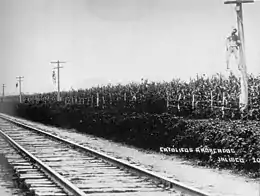
Los Altos was one of the main scenarios of the Cristero War during the early 20th century, which confronted Catholic peasants and Catholic elites against the anti-clerical government of President Plutarco Calles. The confrontation still is strongly remembered and plays an important role for the cultural identity of Los Altos.[19]
Culture
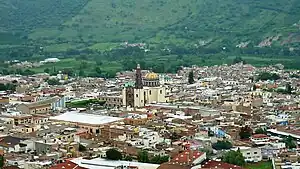
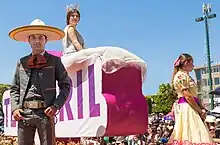
Tequila
Los Altos is one of the two main tequila producing regions in the state of Jalisco, the other being the municipality of Tequila, Jalisco. The main tequila producing center in the region is Arandas[20] and the second region is Atotonilco El Alto.[21]
Charro
Jalisco's charro tradition is particularly strong in the Los Altos region. In Spain, a charro is a native of the province of Salamanca, especially in the area of Alba de Tormes, Vitigudino, Ciudad Rodrigo and Ledesma.[22] It's likely that the Mexican charro tradition derived from Spanish horsemen who came from Salamanca and settled in Los Altos de Jalisco.
Architecture of Los Altos
Some of Los Altos's older architectural structures, both Pre-Hispanic and colonial, have been designated Pueblo Mágico or National Patrimony protected by Mexico's INAH for their historical, cultural or artistic significance. Lagos de Moreno is only one city in Los Altos de Jalisco on the lists of Pueblo Mágicos. The architecture in Los Altos is heavy influenced by European architects during the Spanish Colonial to early WWI era.
Pilgrimage

Los Altos have many shrines. San Juan de los Lagos is the second most visited pilgrimage shrine in Mexico, after the Basilica of Our Lady of Guadalupe in Mexico City . The numerous shrines are important tourist attractions for the state of Jalisco:
- Our Lady of San Juan de los Lagos, in San Juan de los Lagos.
- Our Lady of the Assumption, in Jalostotitlán.
- Martyred Saint Toribio Romo González, in Santa Ana de Guadalupe, municipal of Jalostotitlán.
- Martyred Blessed Anacleto González Flores in Tepatitlan de Morelos.
- Martyred Blessed Miguel Gomez Loza in San Francisco de Asis, municipal of Atotonilco el Alto.
- Martyred Saint Julio Alvarez Mendoz in San Julian, Jalisco.
- Martyred Saint Atilano Cruz-Alvarado in Teocaltiche.
- Venerable Mother Maria Luisa Josefa of the Most Blessed Sacrament in Atotonilco El Alto.
- Martyred Saint Pedro Esqueda Ramírez in Teocaltitán, municipal of Jalostotitlán.
- Martyred Saint Sabas Reyes Salazar in Tototlan.
- Holy Child of the Little Peanut (Santo Niño del Cacahuatito) in Mezquitic de la Magdalena in municipal of San Juan de los Lagos.
- Nuestra señora la virgen del Rosario.
Administration
Since 1996, Los Altos has been organized administratively by the state of Jalisco into two regions, the North Highlands (Altos Norte) and the South Highlands (Altos Sur).
North
The North Highlands (Altos Norte) region covers 8,882 km², which represents 11% of the state's territory. The municipalities in the region are the following:
Lagos de Moreno is the municipality seat of the North Highlands. In this region, factories develop clothing, furniture, footwear, metal goods, sweets and jams. Some of the municipalities in this region have a very important livestock activity mainly in the production of dairy products.
South
The South Highlands (Altos Sur) region has 6,667 km², which is 5% of the state's surface. The municipalities of this region are the following:
Tepatitlán de Morelos is the municipality seat of the South Highlands. In this region is the most recent municipality of the State, San Ignacio Cerro Gordo, which was separated from Arandas. Traditionally Atotonilco el Alto, Ayotlán, Tototlán and Degollado belong to this southern zone of Los Altos. In general, the region has the production of tequila and the development of livestock, clothing, and various crafts.
Notable Alteños
 Monument to Primo de Verdad in Mexico City, lawyer and prominent intellectual author of Mexican Independence.
Monument to Primo de Verdad in Mexico City, lawyer and prominent intellectual author of Mexican Independence.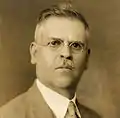 Mariano Azuela, physician and novelist of the Mexican Revolution.
Mariano Azuela, physician and novelist of the Mexican Revolution. Mural by painter Jorge González Camarena.
Mural by painter Jorge González Camarena. Electrical engineer and color TV pioneer, Guillermo Gonález Camarena.
Electrical engineer and color TV pioneer, Guillermo Gonález Camarena..jpg.webp) Professional footballer Isaac Brizuela (born in San José, California to Alteño parents).
Professional footballer Isaac Brizuela (born in San José, California to Alteño parents). Toribio Romo, martyr and Catholic saint.
Toribio Romo, martyr and Catholic saint.
Politics
- Luis Alfonso de Alba Góngora, Mexican under-secretary for Latin America in the Secretary of Foreign Relations, former Mexican Representative to the United Nations (Lagos de Moreno)
- Ramón Muñoz Gutiérrez, Senator of Jalisco in the Mexican Senate of the Republic (Lagos de Moreno)
- Emilio González Márquez, former Governor of Jalisco (Lagos de Moreno)
- Pedro Moreno, general and father of the Mexican War of Independence (Lagos de Moreno)
- Francisco Primo de Verdad y Ramos, 18th-century lawyer and politician of colonial New Spain (Ojuelos de Jalisco)
- Victoriano Ramírez, Mexican general of the Cristero War (San Miguel el Alto).
- José González Gallo, Mexican lawyer and politician who served as Governor of Jalisco (Yahualica de González Gallo).
- Rita Pérez de Moreno, Mexican insurgent and heroine of the Mexican War of Independence (San Juan de los Lagos).
Culture
- Lola Álvarez Bravo, famed photographer, prominent figure of the post-Mexican Revolution artistic renaissance
- Juan Pablo Villalobos, author and entrepreneur
- José Rosas Moreno, 19th-century writer, fableist, and poet
- Mariano Azuela González, 19th/20th-century literary critic, novelist, and essayist
- Jorge González Camarena, Mexican painter, muralist and sculptor, his parents were originally from Arandas.
- Guillermo González Camarena, Mexican electrical engineer who was the inventor of a color-wheel type of color television, brother of Jorge.
- Juan Sandoval Íñiguez, Mexican cardinal of the Roman Catholic Church, and served as Archbishop of Guadalajara.
- Alan Estrada, Mexican actor, dancer and singer.
Athletics
- Luis Fernando Macías, professional cyclist, silver medalist at the 2009 Pan-American Road and Track Championship
- Armando Reynoso Gutiérrez, baseball player for the Mexico national team, Mexican Baseball Hall of Fame member
- Isaác Brizuela Muñoz, Mexican-American footballer for C.D. Guadalajara
- Carmelo Reyes González, former professional wrestler
- J. Paco Gonzalez, Mexican-born American Thoroughbred horse racing trainer.
- Antonio Martínez, Mexican-born American professional football player.
- Martín Vásquez, Mexican-American former professional football player and current coach.
- Miguel Angel Gonzalez, Mexican MLB player (Baltimore Orioles, Chicago White Sox, Texas Rangers)
- Martin Barragan, Professional Mexican footballer from Tizapan el Alto who currently plays for Necaxa.
See also
References
- "Amy Coney Barrett nomination fight leaves progressive Catholics feeling unseen". Religion News Service. October 12, 2020. Retrieved May 12, 2021.
- Piña, Ulices (February 22, 2017). "The Different Roads to Rebellion: Socialist Education and the Second Cristero Rebellion in Jalisco, 1934-1939". Letras Históricas (in Spanish). 16 (16): 165–192. doi:10.31836/lh.16.6562. ISSN 2448-8372.
- Moya, José (2010). The Oxford Handbook of Latin American History. Oxford University Press. p. 8.
- Pérez Ortiz, César; López Cortés, Eliseo (2008). "Etnografía situacional de la memoria histórica de la región de Los Altos de Jalisco, México" (PDF) (in Spanish). Archived from the original (PDF) on March 8, 2016. Retrieved October 21, 2023.
- Complutense University of Madrid - Los Mitos Vivos: Itentidad Regional en Los Altos de Jalisco
- Meyer, Jean. "DOCUMENTO: LA FUNDACION DE SAN FRANCISCO DE ASIS, ALTOS DE JALISCO. (documented about poor Spanish, Basque and Galician settlers in Los Altos)" (PDF). www.colmich.edu.mx. Retrieved December 6, 2018.
- http://www.historia-mexico.info/2011/10/los-chichimecas.html Archived March 6, 2016, at the Wayback Machine Chichimecas
- Desconocido, México (December 2, 2020). "Algunos apellidos de las primeras familias españolas asentadas en Jalisco". México Desconocido (in Spanish). Retrieved October 21, 2023.
- "Genealogía de la expansión de las familias troncales que poblaron las orillas orientales y Norte de Los Altos. Segunda mitad d | Nuestros Ranchos". www.nuestrosraices.com. Retrieved October 21, 2023.
- Ríos, Julio (April 28, 2014). "Los Altos, región mestiza". Archived from the original on June 30, 2015.
- Osegueda, Rodrigo (April 21, 2020). "Los lomilargos: la gente rubia de Los Altos de Jalisco". México Desconocido (in Spanish). Retrieved October 21, 2023.
- "Francisco MARTIN - Geneanet". gw.geneanet.org. Retrieved November 30, 2018.
- "Presencia judía en Los Altos de Jalisco | Diario Judío México". Diario Judío: Diario de la Vida Judía en México y el Mundo (in European Spanish). July 19, 2011. Retrieved November 30, 2018.
- Arredondo, Benjamin (June 7, 2018). "El Bable: Del mito judío-sefardí en los Altos de Jalisco". El Bable. Retrieved November 30, 2018.
- "Los Altos, región mestiza". Retrieved January 28, 2017.
- "The History of Jalisco". houstonculture. Retrieved January 28, 2017.
- "Presencia judía en Los Altos de Jalisco". July 19, 2011. Retrieved January 28, 2017.
- "Francisco Primitivo Martín". Retrieved January 28, 2017.
- López, Damián (January 8, 2018). "La guerra cristera (México, 1926-1929). Una aproximación historiográfica / The Cristero War (Mexico, 1926-1929). A Historiographic Survey". Historiografías: 35–52. doi:10.26754/ojs_historiografias/hrht.201112523. S2CID 187566026.
- Gobierno Municipal de Arandas Official website
- Gobierno Municipal de Atotonilco El Alto Official website
- charro in the Diccionario de la Real Academia Española.
Further reading
- Jim Tuck, "The Holy War in Los Altos: Regional Analysis of Mexico's Cristero Rebellion." Tucson, Arizona: University of Arizona Press, 1982, ISBN 0-8165-0779-1


